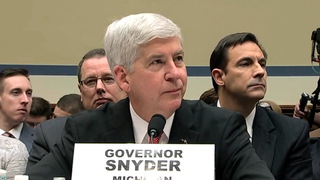
Guests
- Curt Guyetteinvestigative reporter for the ACLU of Michigan. His work focuses on emergency management and open government.
In Flint, Michigan, a growing number of residents are demanding the arrest of Governor Rick Snyder over the ongoing water contamination crisis. Snyder declared a state of emergency for Flint Wednesday, after learning federal prosecutors had opened an investigation into lead contamination in the drinking water. The poisoning began after an unelected emergency manager appointed by Governor Snyder switched the city’s water source to the long-polluted Flint River in a bid to save money. Lead can cause permanent health impacts including memory loss and developmental impairment. Researchers at Virginia Tech who have been testing Flint water say the city could have corrected the problem by better treating the water at a cost of as little as $100 a day. On Thursday, the mayor of Flint revealed it could now cost as much as $1.5 billion to fix the city’s water infrastructure. We speak to Curt Guyette, investigative reporter for the ACLU of Michigan, who has closely covered the story.
Transcript
AMY GOODMAN: We begin our show today in Flint, Michigan, where a growing number of residents are demanding the arrest of Michigan Governor Rick Snyder over the ongoing water contamination crisis. Governor Snyder declared a state of emergency for Flint on Wednesday after learning federal prosecutors had opened an investigation into the lead contamination of the drinking water. Lead can cause permanent health impacts including memory loss and developmental impairment.
The poisoning began after an unelected emergency manager appointed by Michigan Governor Snyder switched Flint’s water source to the long-polluted Flint River in a bid to save money. Researchers at Virginia Tech, who have been testing Flint water, say the city could have corrected the problem by better treating the water at a cost of as little as $100 a day. On Thursday, mayor of Flint revealed it could now cost as much as $1.5 billion to fix the city’s water infrastructure.
For over a year, Flint residents have complained about the quality of the water, but their cries were ignored by state officials. In February, tests showed alarming levels of lead in the water, but officials told residents there was no threat. That same month, an EPA official named Miguel Del Toral wrote an email to the Michigan Department of Environmental Quality warning about lead contamination. No action was taken. He wrote another email in April to the EPA. Then in July, Governor Snyder’s chief of staff, Dennis Muchmore, wrote an email to health officials admitting Flint residents were, quote, “basically getting blown off by us,” unquote.
On Thursday, Governor Snyder apologized again for what happened in Flint.
GOVERNOR RICK SNYDER: This is a situation that no one wished would have ever happened. But it has happened, and we want to be open and honest to say let’s address it, proactively. Let’s go after the issues both in terms of solving what historically—what damage has been done, but also being proactive to prevent future damage and then to do good follow-up to say how we can help people that may have had higher lead levels. So, this is a very comprehensive approach. And hopefully you can see we’re taking this extremely seriously, in terms of the declaration this week, the advisory group I asked to look into it. As each case, as they’ve come forward with recommendations, I think we’ve acted very promptly in implementing what they’ve recommended that we do. And now I’m looking forward to a very close partnership with the mayor and the city of Flint.
AMY GOODMAN: Flint residents are now scrambling to find sources of safe water as fears of lead poisoning grow. Forty percent of Flint lives in poverty. Students at the nearby Davison Community Schools just posted a documentary online called Undrinkable, looking at how the Flint water crisis grew. This is an excerpt.
GRANT POLMANTEER: Less than three weeks after Flint’s water was declared safe and in compliance with the Safe Water Act, news leaked that researchers at Virginia Tech University had found traces of lead within Flint’s water. An official press conference held on September 15th confirmed these tests at a local Flint church. The water found in some homes was three times the federal limit of lead within water. Aged lead pipes and lead soldering found in pipes are common throughout the city, not only in city lines, but also in people’s homes, and has been for years. But why is the lead a problem now? It’s the corrosive Flint River that released the lead into the water.
MARK VALACAK: If your house has lead pipes, if your house has copper pipes with lead solder, then there’s the potential, because of the corrosivity of the water, for some of that lead to leach into the water.
GRANT POLMANTEER: On September 24th, a press conference was held at Hurley to show blood test results.
DR. MONA HANNA-ATTISHA: The percentage of children with elevated blood lead levels has increased. The most striking increase is in the zip codes with the highest water lead levels.
GRANT POLMANTEER: Lead is not something meant for the human body. It’s a neurotoxin that is especially dangerous to infants and young children, as it can permanently cause brain damage and can stunt growth.
DR. MONA HANNA-ATTISHA: It’s an emergency. There is—the CDC and the American Academy of Pediatrics, they routinely say there is no safe level of leads. And when we saw an increase in lead levels, and then when the state saw that they also noticed an increase in lead levels, it’s an emergency. You have to do something about it.
AMY GOODMAN: Undrinkable, an excerpt from a new documentary produced by high school students at Davison Community Schools. That’s actually filmmaker Michael Moore’s alma mater.
Well, for more on the crisis, we’re joined by two guests in Detroit. Investigative reporter Curt Guyette of the ACLU of Michigan is back with us. Nayyirah Shariff of the Flint Democracy Defense League also joins us there. And joining us from Virginia Tech is professor Marc Edwards, an expert on municipal water quality who’s been studying Flint’s water crisis. And we’ll find out in a moment why students and professors at Virginia Tech—in Virginia—are analyzing Flint’s water. But I want to start with Curt Guyette.
Curt, take us through the chronology that takes us to yesterday, the governor once again apologizing—when the governor, the city, the state knew what they knew, why Flint came off of Detroit’s water supply and started getting the contaminated Flint water for their residents.
CURT GUYETTE: Well, as you said in your introduction, this was a decision made while the city of Flint was under the control of a state-appointed emergency manager and, in a purely economically driven decision, decided—
AMY GOODMAN: So, just to say—state-appointed emergency manager. So you have a mayor, but Governor Snyder appointed someone over him, unelected, to run the city.
CURT GUYETTE: Correct. And the elected officials only had as much power as that emergency manager decides to give them. Their pay is determined by the emergency manager. What authority they have, if any at all, is determined by the emergency manager. So, essentially, at that point, the mayor and City Council are employees of the appointed emergency manager. And there is a—
AMY GOODMAN: And the emergency managers throughout Michigan are mainly, almost overwhelmingly, appointed in mainly African-American cities.
CURT GUYETTE: Correct. Of the school districts and cities where emergency managers have been appointed, I think all except one are majority-African-American cities and school districts. And also, they are very high percentage of people living in poverty. So, they’re cities with majorities people of color and very poor cities. And they were—one of the reasons that they were pushed into the financial duress that they were put in was because of cuts in revenue sharing imposed by this governor. So they pretty much pushed them over the financial edge and then took them over.
And these emergency managers can sell off assets. They can break collective bargaining agreements. They can cut the healthcare benefits of retirees. They can break—abolish ordinances, create new ordinances. About the only thing that the law says that they specifically cannot do is miss a bond payment. So, they have—
AMY GOODMAN: And so, they can also change the water supply of a city.
CURT GUYETTE: Correct. And that’s what they did in Flint in order to save—at the time, the claim was that it would save about $5 million a year. And the plan was, if they—
AMY GOODMAN: And explain what they shifted.
CURT GUYETTE: They went from—they had been on the Detroit system for 50 years, getting clean, safe water from Detroit. And prior to that, a decision was made that they were going to join a project to build a pipeline from Lake Huron to Genesee County, where Flint is, which is about 70 miles northwest of Detroit. They were going to build this new pipeline. And while they were building the pipeline, in order to save money for maybe a period of like two years, the decision was made to start using the very, very corrosive Flint River to supply the city’s water.
AMY GOODMAN: So, take us back to last February. Take us to when people started to realize what was going on and the EPA memo.
CURT GUYETTE: Yes. Well, people knew from the beginning, as soon as the switch was made in April of '14, that the water was bad. It looked bad. It tasted bad. It smelled bad. And there was all sorts of problems throughout 2014. In 2015, one of the residents, LeeAnne Walters, had her water tested by the city, and the lead levels came back at over 100 parts per billion. Of course, there's no safe levels of lead whatsoever. The federal action level is 15 parts per billion. So it was about seven times what the federal action level was. She had it tested a second time, and it came back almost 400 parts per billion. And at that point, the EPA became aware of what those test results were, and started sending emails to the Michigan Department of Environmental Quality, asking them what was going on, asked them what was going on in terms of corrosion control.
Detroit had added phosphates to the water, which creates a biofilm that kind of coats the pipes and keeps lead particles adhered to the pipes rather than letting it leach into the water. The Flint River is many times more corrosive than Detroit. So they switched to a water source that was much, much more corrosive, and when corrosion control was more needed than ever, they inexplicably stopped using it, compounding the problem. And that corrosive water, without corrosion control in it, just began tearing apart the pipes.
And as Dr. Edwards has pointed out, anybody with even a rudimentary understanding of chemistry could have looked at the situation and predicted what would happen. But—and we don’t know. And that’s one of the questions that remain unanswered at this point, is: Did they take a serious look at what was going on with that river before they decided to make the switch? And it’s either they didn’t do that, which I would think is gross negligence, or they did do it and ignored whatever they found. But that’s one of the, I think, big questions at this point that remains unaddressed. So—
AMY GOODMAN: Miguel Del Toral—talk about the significance of who he was within the EPA, the memo he wrote and how he was admonished by his superiors.
CURT GUYETTE: Yeah, Mr. Del Toral is really the unsung hero in this whole saga. He began asking questions. He took a personal interest in the Walters family, went there, looked at their house, established that they didn’t have any lead plumbing, which the city was claiming was the source of the problem, because all along the way everybody involved in the decision to switch to the Flint River did everything they could to deny that the river was what caused this problem to erupt. Mr. Del Toral went there, investigated, hooked Ms. Walters and her family up with Dr. Edwards and the people at Virginia Tech. They conducted their own independent, very, very thorough tests. And they took 30—











Media Options